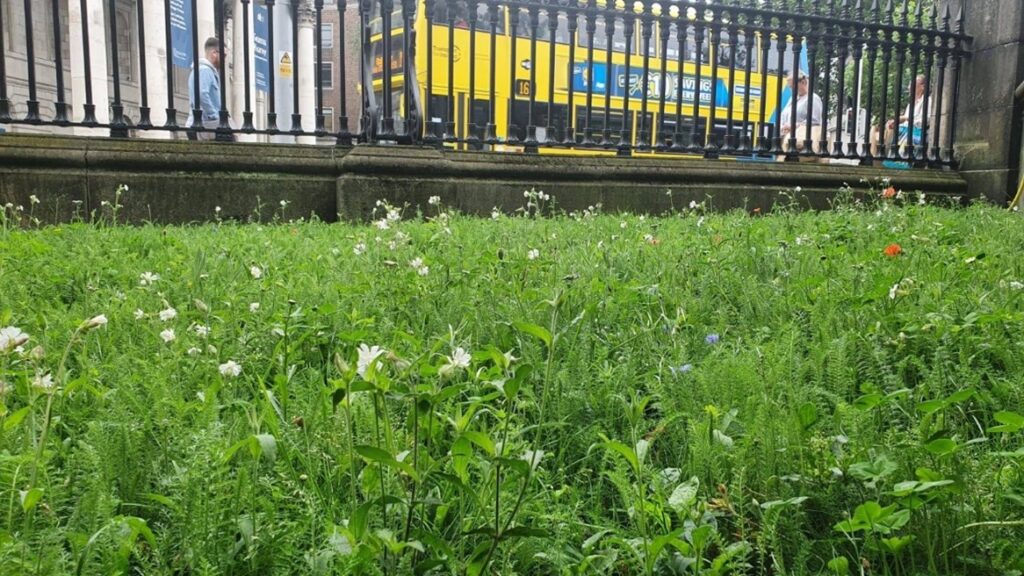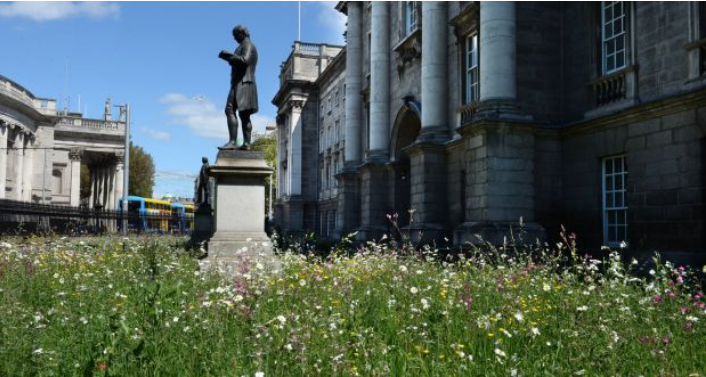by Aoife Robertson

In February 2020, a Trinity Green Campus poll was held amongst Trinity College Dublin (TCD) staff and students to convert the lawns of Front Gate into a wildflower meadow. Of the 13,850 people who voted, 12,496 voted in favour, a 90% majority. This was the largest number of participants that Trinity Green Campus had ever had, likely due to the extensive communications regarding the campaign, with features being included on local, national, and international news channels. The project has been deemed a success with support from both the public and TCD community and it continues to flourish outside the historic Front Gate of TCD. The TCD wildflower meadow is one of many similar “rewilding” projects that are currently being undertaken to increase biodiversity in urban and rural spaces but why are they such a popular rewilding choice? And how can we ensure their success?

Let’s take it that any project, ecological or otherwise, can be deemed successful if it has fulfilled the goals that it set out to achieve. The majority of rewilding and restoration projects aim to introduce species to an ecosystem as a way of restoring ecosystem functions and re-establishing natural processes that existed previously. In the case of wildflower meadows, the species being introduced are herbaceous plants and the ecosystem functions that they aim to restore usually relate to pollination or biodiversity, although this is not always the case. Even the broadest generalisation of the aims of wildflower meadows lacks clarity on the type of ecosystem functions that are expected to be restored. This is due to the aims of any restoration effort being dependent on the social and cultural views of the people carrying out or interacting with the project. Therefore, each individual wildflower meadow project must define the unique aims pertaining to it before a decision can be made on its success.
The two most documented spatial differences are between North America and Europe. In North America, the landscapes that were present before European colonisers have long been idolised and perpetuated as the “perfect wilderness,” with many attempts being made to conserve and restore these ecosystem types. As such, projects which aim to restore pre-colonisation landscapes are often deemed to be successful and are well received by the public. Large wildflower meadows that are re-planted in areas that previously were inhabited by similar species and vegetative communities are also deemed successful and serve as a reminder of the great prairies and grasslands of 1500’s North America. However, when urban wildflower meadows are planted many North Americans question whether it is truly restoration, since there were no previous wildflower meadows present here which can be said to be restored. Therefore, if the aim of this example is to be an act of restoration or rewilding the project is unable to be successful.
Contrasting to this, European rewilding does not explicitly try to recreate a single period, owing to the long established agricultural and industrial disturbance that has been occurring in the area since ~7000 B.C.. Therefore, the matter of projects emulating an exact period does not cause the same obstacles to success that are seen in North America. Instead, a range of dates are replicated, from Pleistocene to pre-industrial. There is a much lesser demand for projects on the large scales seen in North America, with the reintroduction of large carnivores causing public outcry. When concerning wildflower meadows, small pockets of pre-existing meadows or similar habitats are still naturally established in Europe, such as hedgerows and agricultural wildflower meadows. Thus, it is easier for people to view wildflower meadows projects as restoration.
Education also plays a key role in the success of wildflower meadows. Some studies have shown that the public perceives nature as consisting of trees and forested areas, and so projects that remove trees, even for positive environmental reasons, are perceived negatively. Other studies, however, have shown contrasting results, recording preferences towards annuals over larger trees or fruit plants. Interestingly, this same study also recorded that 54% of participants did not know what wildflowers were. This indicates that asking the public whether they prefer wildflowers over trees may not give accurate data as the responders are much more familiar with one subject over the other. Where images were shown, participants revealed a preference for wildflower meadows over images of herbaceous and formal bedding styles. The degree to which they preferred wildflower meadows over other bedding styles increased with an increase of plant species richness. This is a positive sign for those who wish to use wildflower meadows to restore pollinator and biodiversity functions, as it suggests that there should be public support of the projects if the public are adequately informed on wildflower meadows.
The TCD wildflower meadow project had clear goals, aiming to demonstrate that grass lawns were not the only option for planting in a formal setting. By prioritising the goal of informing the public on the project aims, TCD reduced arguments that may have otherwise arisen over the success of the project. Notably, before the project began, the idea was put to a vote by the staff and students at the college. As mentioned previously, the poll was hugely successful likely due to the amount of publicity it received. In order to combat any doubt surrounding the use of non-native species, information was provided about the reasoning for including non-native species and why they would be beneficial to the project, for example, the increased pollination potential of the site and the aesthetic benefits of the species chosen. The clear communication regarding the project appears to have ensured the wildflower meadows success. The public support for a wildflower project in the heart of the capital city centre could also in part be due to the site being in Europe. Alternatively, the public support could be due to the project being planted shortly before the Covid-19 pandemic, which has been hypothesised to have increased public appreciation for green spaces. Many of the questions posed remain unanswered due to the modernity of the topic and rapidly shifting public opinions. As developments occur, both academically and publicly, more light will be shed on the success of wildflower meadows and how projects can be best implemented. However, for now, debates on the topic should be encouraged and the public should be involved in the conversation. Wildflower meadows have a huge potential to educate people about their environment and can be implemented on many scales, being made suitable to whichever environment is present. The people managing these projects should consider the ecological and social environment within which they work and make efforts to adapt to the unique environment in which they may find themselves. There is plentiful research into the social dynamics of rewilding and restoration projects and so it can be concluded that the issue lies with project managers and a potential lack of consideration of the social factors at hand.
Aoife is a final year Environmental Sciences student at Trinity College Dublin who recently completed her undergraduate thesis with Dr Piggott and Dr Penk. She is interested in urban rewilding and quantitative ecology and hopes to work in these areas in the future.
